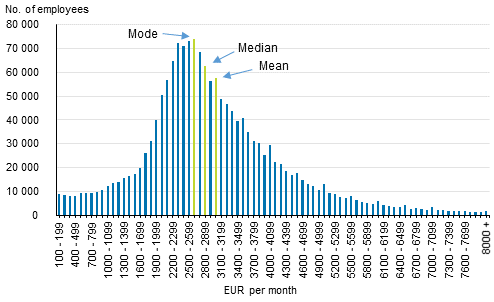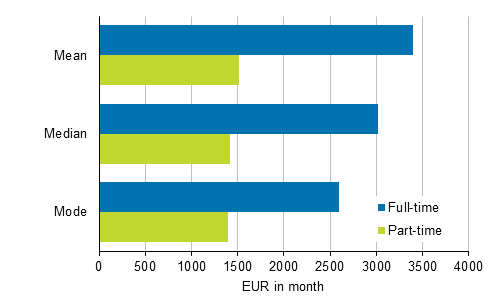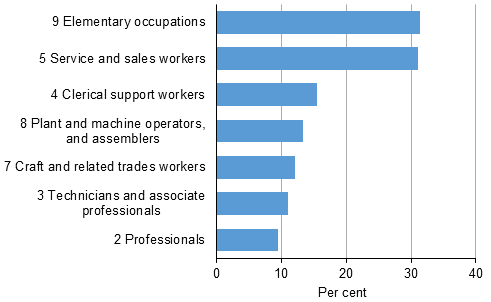Published: 13 September 2018
Most common earnings of ordinary and public sector employment contracts EUR 2,600 per month in 2017
According to Statistics Finland’s Structure of Earnings statistics, the most common earnings of ordinary and public sector employment contracts were EUR 2,600 per month in 2017. Besides basic pay and scheduled pay, total earnings include supplements, overtime pay and benefits in kind. Total earnings are in gross, so taxes or other payments have not been subtracted from them.
Distribution of total earnings in ordinary and public sector employment contracts in 2017

The Structure of Earnings statistics describe wage and salary earners working in enterprises with more than five employees in the public and private sectors. The figure above presents the number of full-time and part-time employees with ordinary and public sector employment contracts according to monthly earnings.
In the figure, earnings have been divided into categories of EUR one hundred. In absolute numbers, there were most ordinary and public sector employment contracts earning between EUR 2,600 and 2,699. This is the most common (mode) earnings category. Typical occupations in this group are nurses, social work assistants, heavy truck and lorry drivers, bank tellers and related clerks.
The median for total earnings of ordinary and public sector employment contracts was EUR 2,816. Of employees with ordinary and public sector employment contracts, 50 per cent earned less than this, 50 per cent more than this.
The average of total earnings was EUR 3,087 per month. In the statistics, monthly earnings were lower than average for 60 per cent of those with ordinary and public sector employment contracts. This is explained by the fact that the biggest total earnings raise the arithmetic average.
Most common earnings of employees with part-time ordinary and public sector employment contracts EUR 1,400
In 2017, the most typical earnings were EUR 1,400 to 1,499 per month for part-time employees with ordinary and public sector employment contracts. The median for total earnings was EUR 1,421, and the average EUR 1,519 per month.
The figures above are earnings specific for ordinary and public sector employment contracts. They do not simply tell the amount of earned income for part-time employees, because a part-time employee may be simultaneously working with more than one ordinary and public sector employment contract and/or as self-employed.
According to the employment statistics data for 2016 combined to the Structure of Earnings statistics, 16 per cent of part-time employees worked with one or more ordinary and public sector employment contracts or were self-employed. In other words, 16 per cent of those working part-time had more than one job.
The employment relationship is part-time if its regular weekly working hours are less than 90 per cent of the regular weekly working hours in the field.
Key figures for full-time and part-time employees with ordinary and public sector employment contracts in 2017

In the Structure of Earnings statistics, part-time employees made up 17 per cent of those with ordinary and public sector employment contracts
The Structure of Earnings statistics included around 1,670,000 ordinary and public sector employment contracts in 2017. Of those with ordinary and public sector employment contracts, 16.8 per cent were part-time employees, in total 280,000. This corresponds to the Labour Force Survey, according to which 16.2 per cent of wage and salary earners worked part-time in the last quarter of 2017.
There are clear differences between occupational groups in part-time work. The number of part-time ordinary and public sector employment contracts was highest in occupational groups 5 Service and sales workers and 9 Elementary occupations.
In individual occupational categories of these occupational groups, part-time work was most common for paper deliverers, messengers, fast food preparers, waiters and sales workers. For example, 83 per cent of fast food preparers and 64 per cent of waiters were part-time.
Part-time work was less common in occupations of professionals and associate professionals. In occupations of associate professionals part-time ordinary and public sector employment contracts were most common for translators and interpreters, dentists and general practitioners.
In all, 24 per cent of doctors worked with a part-time ordinary or public sector employment contract. According to the employment statistics data for 2016, forty-one per cent of doctors working part-time had more than one job.
Share of part-time ordinary and public sector employment contracts according to the main groups of the Classification of Occupations 2010 in 2017

The Competitiveness Pact affects hourly earnings
In summer 2016, the labour market organisations agreed on the Competitiveness Pact. For the extension of working time, the pact includes all organised branches, excluding the food industry, the construction industry and the transport field.
In the public sector, the effect of the Competitiveness Pact on regular working hours was clear based on the data of the Structure of Earnings statistics: a rise of half an hour per week. As a result of the extension of working time, the average total hourly earnings fell in both the local government and central government sectors.
In the private sector, the average regular working time also grew from the previous year, and the average total hourly earnings for full-time wage and salary earners were in 2017 slightly lower than in 2016.
The 24 hour extension in yearly working time according to the Competitiveness Pact reduced computationally hourly earnings by around 1.3 to 1.5 per cent depending on the length of regular working time.
The final data for 2017 will be published in February 2019
The preliminary Structure of Earnings statistics for 2017 provide data on the earnings of around 1.67 million wage and salary earners. The statistics typically use the term wage and salary earner as a synonym for employees with ordinary and public sector employment contracts.
The data in the Structure of Earnings statistics are collected from monthly-paid wage and salary earners for September, October or November, and from hourly-paid wage and salary earners for the last quarter of the year. The statistics do not include data on the top management of private sector enterprises.
The data of the preliminary Structure of Earnings statistics will become revised in terms of level and field of education in the final release of 2017 data in February 2019. The statistics will also be complemented with data concerning the workplace's industry and location.
Source: Structure of Earnings 2017, Statistics Finland
Inquiries: Sampo Pehkonen 029 551 3452, Jukka Pitkäjärvi 029 551 3356, palkkarakenne@stat.fi
Director in charge: Mari Ylä-Jarkko
Publication in pdf-format (222.2 kB)
- Tables
-
Tables in databases
Pick the data you need into tables, view the data as graphs, or download the data for your use.
Appendix tables
Updated 19.2.2018
Official Statistics of Finland (OSF):
Structure of Earnings [e-publication].
ISSN=1799-0092. 2017. Helsinki: Statistics Finland [referred: 19.12.2025].
Access method: http://stat.fi/til/pra/2017/pra_2017_2018-09-13_tie_001_en.html

